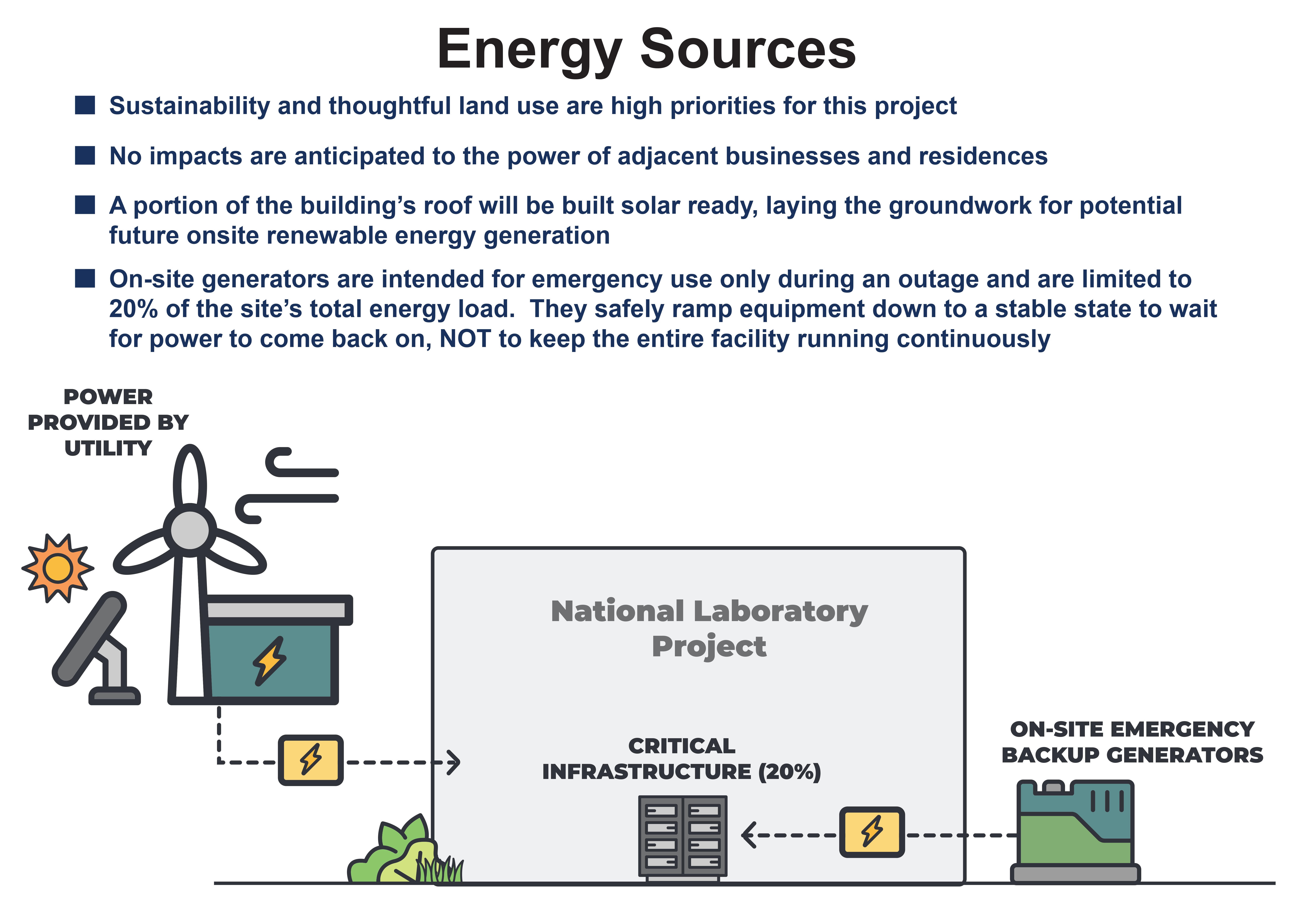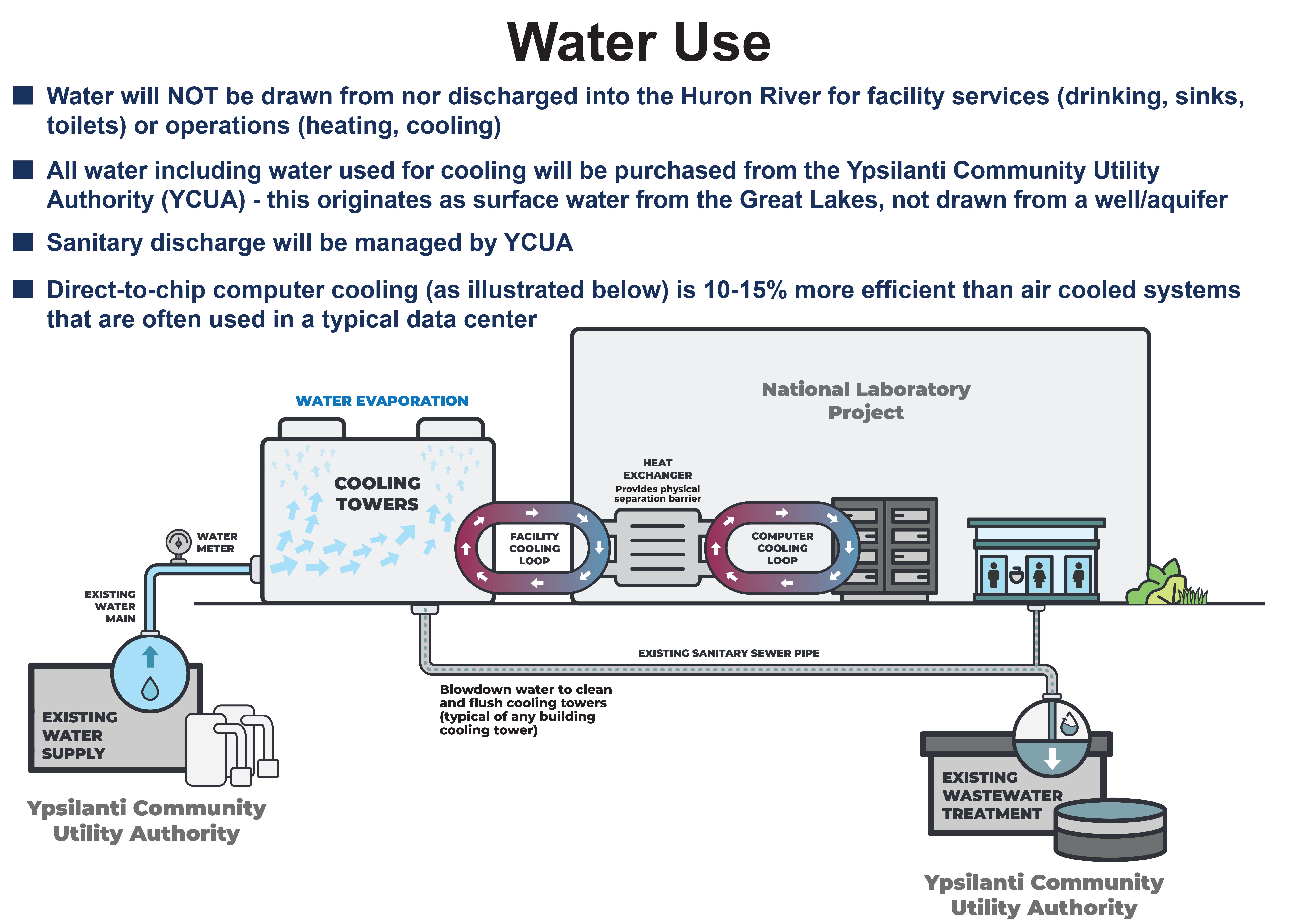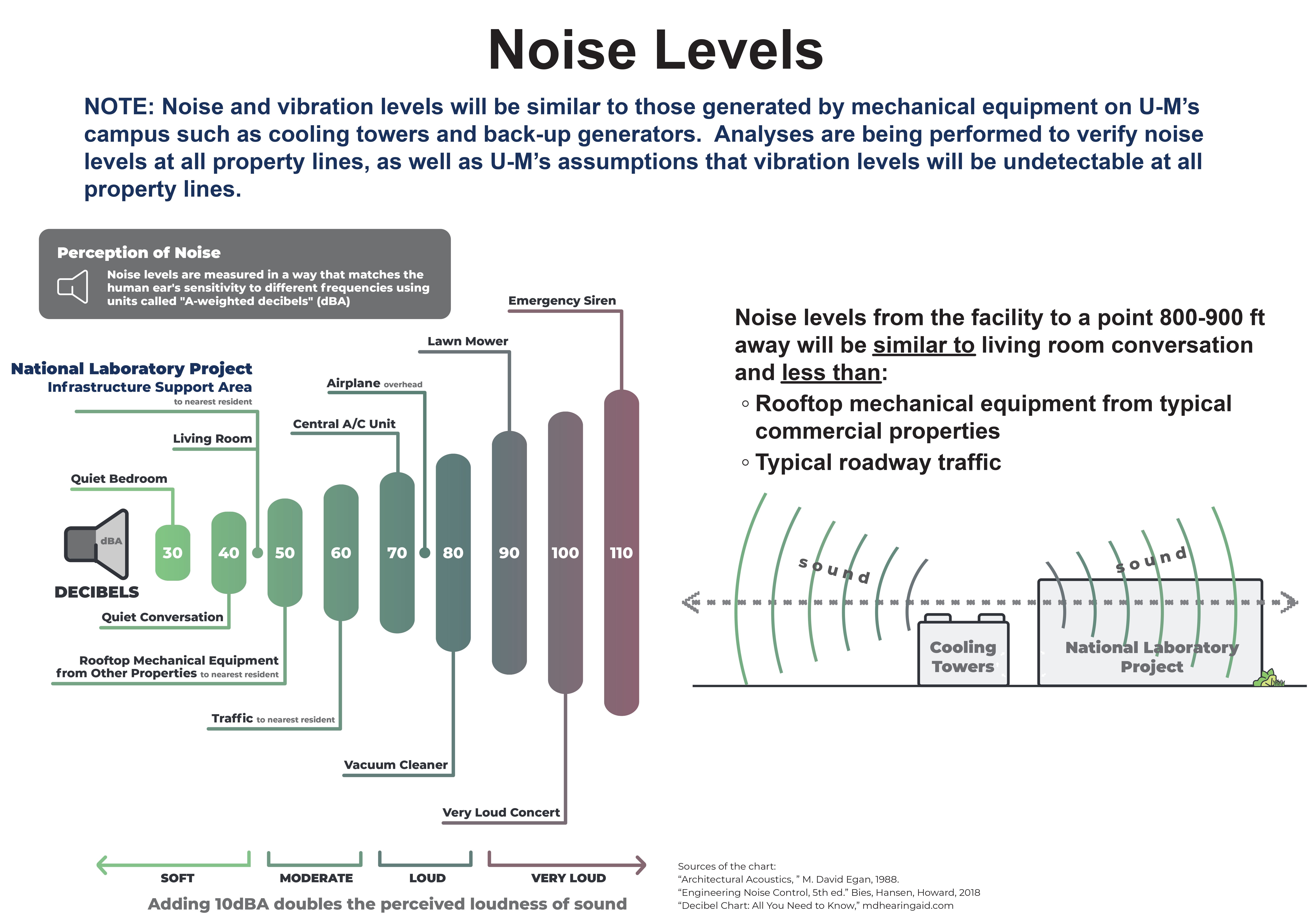High-performance computing facility with Los Alamos National Laboratory
The University of Michigan and Los Alamos National Laboratory are collaborating to create a new facility for high-performance computing and AI research in Washtenaw County focused on science, energy and national security. The state-of-the-art facility will create hundreds of jobs, strengthen the university’s impact in research and education, and be a catalyst for economic development and innovation in the region.
Read the initial announcement about the facility and see below for answers to common questions about the exciting new partnership.
ABOUT THE PROJECT
The following FAQ – updated in July 2025 – is designed to provide clear, accurate information about the ongoing collaboration between the University of Michigan and Los Alamos National Laboratory. It addresses common questions and corrects potential misunderstandings about the purpose, scope and impact of the new research facility.
What is the project?
The University of Michigan (U-M) and Los Alamos National Laboratory (LANL) are collaborating to create a new national research center in Washtenaw County. This high-performance computing facility will support important research in science, energy and national security.
The university is not building a commercial data center.
What will this project include?
- A facility for federal, classified research.
- A smaller, adjacent academic facility for non-classified research, which will be used by U-M faculty, staff and students, with potential opportunities for use by other universities.
What is “high-performance computing” and how is it used?
High-performance computing involves solving complex problems by running sophisticated algorithms across thousands of processors (smaller computers) working together in parallel. High-performance computing, for example, allows researchers to rapidly test millions of potential drug compounds and identify promising candidates for treating diseases far more quickly than traditional laboratory methods.
Other applications include the discovery and design of new materials, calculations on climate preparedness and sustainability. Industries such as mobility, national security, aerospace, life sciences and finance can benefit from advanced modeling and simulation capabilities.
U-M has been doing this type of high-performance computing research for many years, but at a smaller scale. As the university looks to solve more complex problems, it needs faster computing speeds and more computing capacity.
What is the difference between a high-performance computing facility and a commercial data center?
A high-performance computing facility is built for scientific research and innovation. It supports projects that benefit the public, from medicine and climate science to energy and national security.
Commercial data centers store and deliver online content, supporting websites, apps, streaming, and private-sector platforms like social media, cloud storage, and e-commerce.
Is this a commercial development?
This is not a commercial development. This is a research collaboration between U-M and Los Alamos National Laboratory, both public entities, designed to advance scientific discovery, not commercial products, technology, or social media platforms.
Where will the facilities be located?
The university is currently assessing the viability of locating the facility project will be located in Ypsilanti Township on the north side of Textile Road, directly across the street from the Ford Rawsonville Components plant and adjacent to the LG Energy Solutions plant. The buildings would be located closer to Textile Road than the north property lines in order to preserve the site’s natural features and provide additional distance between South and North Hydro parks.
This area is zoned for light industrial and commercial use, and is characterized by wide roads, minimal residential density, and existing utility infrastructure. The surrounding corridor’s manufacturing operations, distribution centers, and open buffer zones make it well-suited for a research and technology facility.
The university has, and will continue to, explore other sites if they are viable in the timeframe needed for successful completion of the project.
How big are the facilities?
The federal facility will be approximately 220,000 to 240,000 square feet. The adjacent academic facility will be approximately 50,000 square feet.
Will this facility manufacture nuclear weapons?
No, the federal facility is for research and high-performance computing. It will focus on scientific computation to address various national challenges, including cybersecurity, nuclear and other emerging threats, biohazards, and clean energy solutions.
COMMUNITY & ECONOMIC BENEFITS
The University of Michigan’s new partnership with Los Alamos National Laboratory represents a transformative investment in Michigan’s economy, workforce, and research capabilities. This initiative will not only create high-paying jobs and attract new industries, but also strengthen the state’s position as a leader in innovation.
How will this benefit the broader community?
At the local level:
- Creation of at least 200 high-paying, research-based jobs in Washtenaw County.
- The opportunity to extend economic development and create additional jobs in the region by attracting new industries and businesses that work with classified or secure information.
- Enhanced business and tax revenue generated by associated local economic development.
- Workforce development training opportunities for facility support jobs.
- New construction jobs and business opportunities with construction work performed by union contractors utilizing many local trades.
At the state level:
- Strengthening of Michigan’s role in science and technology and the creation of long-term educational and job opportunities.
- Opportunities for students and early career professionals to stay in Michigan.
- Expansion of Michigan’s research and innovation ecosystem.
- Strengthened partnerships with federal agencies and research institutions.
At a societal level:
- U-M and Los Alamos National Lab are building advanced infrastructure to accelerate research breakthroughs in areas like science, energy, and national security.
Who is funding this project?
The total investment for the project is estimated at $1.25 billion. Under an agreement between LANL and U-M, the national laboratory will directly contribute $300 million. U-M will provide direct contributions of $220 million and facilitate the financing of $630 million. The state of Michigan will provide $100 million through a Strategic Site Readiness Program grant earmarked for site development, construction and other related activities necessary to construct the new research centers.
Is Los Alamos National Laboratory moving a significant part of its operations to Michigan?
No, this will be a new high-performance computing facility that expands LANL’s current computing capabilities. LANL will retain all of its facilities and operations in New Mexico.
How is the community being involved?
U-M has met with township officials and is planning further community engagement opportunities to share information, listen to feedback and answer questions from residents.
How will the partnership benefit U-M research?
The partnership is anticipated to strengthen U-M’s impact and excellence in research and education, offering new capabilities and opportunities to work on tough challenges such as cybersecurity, artificial intelligence, infectious disease and clean energy solutions. The effort is a significant step in continuing to strengthen U-M’s research partnerships with the Department of Energy’s National Laboratories.
What are National Laboratories and what do they do?
National Laboratories are U.S. Department of Energy research institutions that address major scientific and technological challenges, such as energy innovation, cybersecurity, and the development of cutting-edge scientific tools and facilities. The labs conduct large-scale, multidisciplinary research and operate unique facilities across the country.
Read more about the nation’s national laboratories.
What other National Laboratories does U-M partner with?
In addition to its latest partnership with LANL, U-M maintains strong collaborative research agreements with a number of other National Laboratories, including Idaho National Laboratory, Argonne National Laboratory and Fermilab in Illinois, Oak Ridge National Laboratory in Tennessee and Pacific Northwest National Laboratory in Washington state.
ENVIRONMENTAL CONSIDERATIONS
The University of Michigan is committed to ensuring that the new facility is developed in a way that protects the environment, supports local infrastructure, and minimizes disruption to the community. From safeguarding the Huron River to incorporating sustainable design features, every aspect of the project is being carefully planned to align with environmental best practices.
Will local infrastructure be able to support this facility?
- No wastewater will be released into the Huron River.
- DTE will construct a new electrical substation near the site.
- All necessary infrastructure improvements are included in the project’s scope.
Will this affect the local power grid reliability?
A new DTE substation will be designed and built to fully accommodate the facility’s energy needs, and the availability of electricity to adjacent businesses and residences will not be impacted.

Will the facility have an impact on the Huron River? How about area wetlands?
Sustainability and thoughtful land use are high priorities for this project. The facility will not draw from or discharge into the Huron River. All cooling water will be purchased from local municipal utilities, and sanitary discharge will also be handled through the municipal system.
Plans for site stormwater management, as well as any potential impacts to regulated wetlands on the property, are subject to review and permitting from the Michigan Department of Environment, Great Lakes, and Energy (EGLE). The university will work closely with EGLE to ensure minimal impact and that the project meets applicable EGLE requirements. U-M will also preserve existing vegetation where it is possible.

Should nearby residents expect any health or sensory impacts, such as fumes, noise, or vibrations?
No. Once the facility is up and running, residents should not experience any smoke, odor, significant noise, or vibrations. The buildings are designed to operate cleanly and quietly, with all-electric infrastructure and minimal emissions.
During construction, there may be temporary noise or vibration typical of large building projects. These activities will follow all relevant regulations, and U-M will work with contractors to minimize disruption to nearby properties.

What steps is the university taking to reduce environmental impact?
The project will employ integrated design principles to ensure energy efficiency, water conservation, occupant comfort and minimal environmental impact to the project site.
In keeping with the university’s carbon neutrality goals, the project will be all-electric. Only 20% of the facility’s power will be supplied by back-up generators in the event of an outage.
The building’s design and systems include several energy-efficient features to achieve better than 20% energy savings compared with an energy-code-compliant building, as defined by ASHRAE 90.1-2013.
This project has a minimum LEED certification goal of LEED Silver with a stretch goal of LEED Gold under LEED v4 for Data Centers.
Low-flow plumbing fixtures will reduce water consumption by 20% beyond the Michigan Plumbing Code requirements.
The project will purchase ENERGY STAR equipment.
Construction waste will be diverted from landfills whenever possible.
The university’s recent collaborations with the U.S. Department of Energy’s National Labs, including Los Alamos, have been especially fruitful. Discoveries made at the national laboratories have saved lives, solved mysteries of nature, improved products, transformed industries, and served as a training ground for students who go on to pursue careers in science and technology.
Read: Legislative support bolsters U-M, Los Alamos computing facility (Dec. 20, 2024)
Read: U-M, Los Alamos to develop AI research facility in Michigan (Dec. 5, 2024)
Read: $15M to fund U-M, Los Alamos National Laboratory collaborations (May 15, 2024)
Press Inquiries
Please reach out to the Office of Public Affairs at (734) 936-5190 or [email protected].
